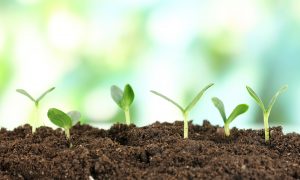The U.S. Geological Survey recently released new maps that show what is in our soil. This information is beneficial to both agriculture and public health experts because it helps pinpoint places where food safety issues might arise because of the composition of the soil.
The release of these new maps got us at Fill Your Plate thinking about the important role soil plays in producing the food we all use to fill our plates. The quality of the soil impacts everything from what kind of food we can grow to the cleanliness of our water. It is the foundation of every ecosystem on the planet and these new maps increase our understanding of the natural variations in soil composition across the country.
One of the goals of this mapping project was to provide a baseline of the current status of the soil across the country. This baseline will allow scientists and other experts to monitor changes in the soil over time. Creating this baseline will make it possible to determine if future changes in soil composition are naturally occurring or if they are a consequence of human habitation. Without this baseline, it is impossible to determine if increases in certain minerals or chemicals in the soil are due to waste disposal practices or if they have occurred naturally.
The mapping project was a massive effort and more than 24,000 soil samples were collected from 4,800 locations over a three year period. Sample collectors came from a variety of government agencies and universities and followed guidelines defining where soil samples could be sourced within pre-selected target areas. According to these guidelines, soil samples could not be taken:
- Within 200 meters of a major highway
- Within 100 meters of any building or manmade structure
- Within 50 meters of a rural road or street
- Within 5 kilometers downwind of any power plant or smoke stack
As part of the collection process, sample takers obtained permission from any private land owners prior to collecting any samples. The success of the project is partially credited to the numerous landowners who happily cooperated and allowed soil samples to be taken from their property.
Prior to the release of this study, much of the national scale data available came from a study conducted in the 1960s and 1970s that used outdated techniques and methodology. Creating this baseline allows experts in a variety of fields spanning from agriculture to public health to understand how changes in the nation’s soil composition are occurring and how those changes impact our water, food supply, health, and future. With a better understanding of how specific practices, types of pollution, or waste management practices impact the soil, policy makers will be better able to protect this valuable natural resource.
For more information about the Geochemical and Mineralogical Data for Soils of the Conterminous United States survey visit the U.S. Geological Survey’s report here.





